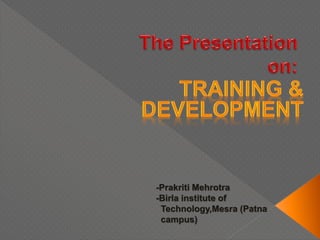
Training & Development and its competencies
- 1. -Prakriti Mehrotra -Birla institute of Technology,Mesra (Patna campus)
- 2. Training & development is an attempt to basically improve the current & future performance of employees by enriching & enhancing their abilities . It focuses on brushing up the qualities & strengths of an employee to improve his /her overall performance .
- 4. 1. It is a systematic learning , always better than hit & trial methods for improving competencies of employees . 2. Enhances employee productivity (qualitative as well as quantitative) ,leading to higher profits. 3. Increases employee morale reducing turnover and absenteeism 4.It equips the future manager who can take over in emergency cases. 5. Helps in developing leadership & motivation skills,better attitude etc ,which every successful employee needs to possess.
- 5. Skills-Training involves imparting of basic important skills without which no employee can perform functions. Education-it is to teach theoritical concepts & development of sense of reasoning & judgement. Mostly important at higher levels. Development- less skill oriented learning ,but focuses on knowledge about overall business environment,principles,human relations etc.
- 6. Ethics- employees are trained about their behaviour, ethics to work, following rules & policies etc. Attitudinal changes - changing negative attitude to a positive one towards the tasks to be performed .
- 7. Competency is the most important reason why training & Development is required in every organisation. It is the ability to do something successfully & efficiently . It is a set of knowledge ,skills and abilities which helps a company categorise and differentiate each employee for different tasks.
- 8. Any behaviour attribute such as knowledge, skill set, teamwork, leadership skills, technical know-how, etc which contributes to the development of an individual in the organisation to take up bigger roles is known as behaviour competency. Types of Behavioural competencies are : Communication skills Business acumen Innovation skills Getting results Vision and strategy Team work
- 9. Team work skills are the abilities to combine the work of different workers for a common objective .
- 10. A teamincludesthe supervisors,workers,co- workers,isperctorsand every element ofthe team collaboratestheirequal and undifferentiatedeffort towardsorganisational goals.
- 11. Motivates unity in the workplace environment. Improved efficiency and productivity. Provides learning opportunities. Promotes workplace synergy.
- 12. Helping &guiding Persuading Exhibits flexibility Functioning as a active participant Show commitment to the team
- 13. Communication is a two-way process of exchange of ideas ,data & information among two or morepeople .Having potential communication skills –verbal& written is veryessential in every organisation.
- 14. Communication Verbal Non-verbal The process of conveying a type of information in the form of non-linguistic representations. Examples of nonverbal communication include gestures, body language, facial expressions, eye contact, and how one dresses. Verbal communication is the spoken or written conveyance of a message.
- 15. Helps with diversity-Good communication skills help to reduce the barriers erected because of language and cultural differences. Global business-Companies that prepare workers to excel with verbal and nonverbal communications skills find it easier to enter into global marketplaces than companies that do not prepare its employees. Effective communication is important for businesses looking to expand beyond its domestic borders.
- 16. Team Building- Effective communication reduces unnecessary competition within departments and helps employees work together harmoniously , also avoiding any overlapping of activities. Employee Morale-When employees are satisfied with their jobs, they are able to efficiently perform their duties with a positive attitude. Failing to communicate effectively in a workplace leads to frustration and confusion among employees.
